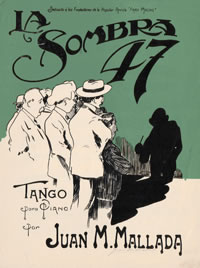By
The “Fray Mocho” magazine and a tango dedicated to it

n May 13, 1912 the Fray Mocho magazine appeared in Buenos Aires. Its size was a little smaller than Caras y Caretas, its predecessor.
 How, when and why Fray Mocho was born? At the house of the comedy playwright and diplomat Tito Livio Foppa —a former anarchist, devoted, in his latter years, to the more pleasant occupation of collecting sumptuous isabelinos, beautiful Spanish bargueños (desks with drawers) and expensive ivory pieces— we met the brilliant journalist, quite old then, Juan José de Soiza Reilly. The latter was famous for his saying «My time is over!»— and he also made and even made up memorable interviews, was a witness of important street events, wrote La muerte blanca (The white death, about cocaine), El alma de los perros (The soul of dogs) and he, somehow, discovered and protected Roberto Arlt.
How, when and why Fray Mocho was born? At the house of the comedy playwright and diplomat Tito Livio Foppa —a former anarchist, devoted, in his latter years, to the more pleasant occupation of collecting sumptuous isabelinos, beautiful Spanish bargueños (desks with drawers) and expensive ivory pieces— we met the brilliant journalist, quite old then, Juan José de Soiza Reilly. The latter was famous for his saying «My time is over!»— and he also made and even made up memorable interviews, was a witness of important street events, wrote La muerte blanca (The white death, about cocaine), El alma de los perros (The soul of dogs) and he, somehow, discovered and protected Roberto Arlt.
Soiza Reilly was the witness of an episode that he told us about and of which he was also protagonist. The Caras y Caretas magazine —in which Soiza Reilly worked for a long time— had a very talented caricaturist, undoubtedty, one of the stars of the publication: the Galician drafstman and writer José María Cao. Cao was an almost angelic being, protector of the poor, advocate for anybody he knew that was in disgrace, a stupendous draftsman that, also, used to complete the caricatures in the magazine with a saying at the bottom of the character at issue, absolutely matching the case.
In the magazine he was admired and loved by everybody. He was absolutely neat in choosing colors and other characteristics for the things that had to be printed to the point of perfection he was aiming for.
He had no other fault but his fear for infectious diseases. Because of that he used to often wash his hands and in a thousand ways he tried to avoid possible contagion.
Always dependable in the tasks he had to carry out, his irreproachable punctuality did not help him, however, in the unfortunate situation that occurred to him once. He had a son that was sick and, in order to take due care of his ailing son, he asked the managers of the magazine for a short leave. The answer was negative.
 This inconsiderate rejection —Soiza Reilly said— annoyed all the workers. Forty-six of the main editors and draftsmen decided to support him and quit Caras y Caretas together with Cao, one of the great stars of the publication.
This inconsiderate rejection —Soiza Reilly said— annoyed all the workers. Forty-six of the main editors and draftsmen decided to support him and quit Caras y Caretas together with Cao, one of the great stars of the publication.
They left, then, and decided to found another magazine. So Fray Mocho was born. Its first number appeared in Buenos Aires on May 3, 1912. It was directed by the historian and journalist Carlos Correa Luna. Among the art collaborators were, along with Cao himself, the Asturian Juan Peláez (1880-1937) (the one who painted the beautiful picture of a young Sarmiento teaching in a school of San Francisco del Monte de Oro and the scene of the oath to the flag at the Pasaje river); Friedriech; Juan Hohmann (1880-1935) and, among the editors, Luis Pardo (the ineffable Luis García, the one of the very clever humorous poems) and Félix Lima, the author of Con los 9, a documentary journalist of the Buenos Aires language at the turn of the century.
José Sixto Álvarez (Fray Mocho) had passed away in 1903. As homage to him the magazine would be named, precisely, Fray Mocho. The forty-six editors and draftsmen who quit Caras y Caretas regarded Fray Mocho, who had pleased the readers with his admirable street cartoons and with Un viaje al país de los matreros (A trip to the land of the outlaw gauchos), as a Penate god. He was then “La sombra 47" (“The shadow 47”). So was named a tango published in his honor; the composer of that music was Juan Mallada. In the meaningful illustration of the sheetmusic cover of the tango (which had no lyric) a group of presumed journalists is looking back at a shadow that, with a mate in his hand, personifies the unforgettable author of Salero criollo.